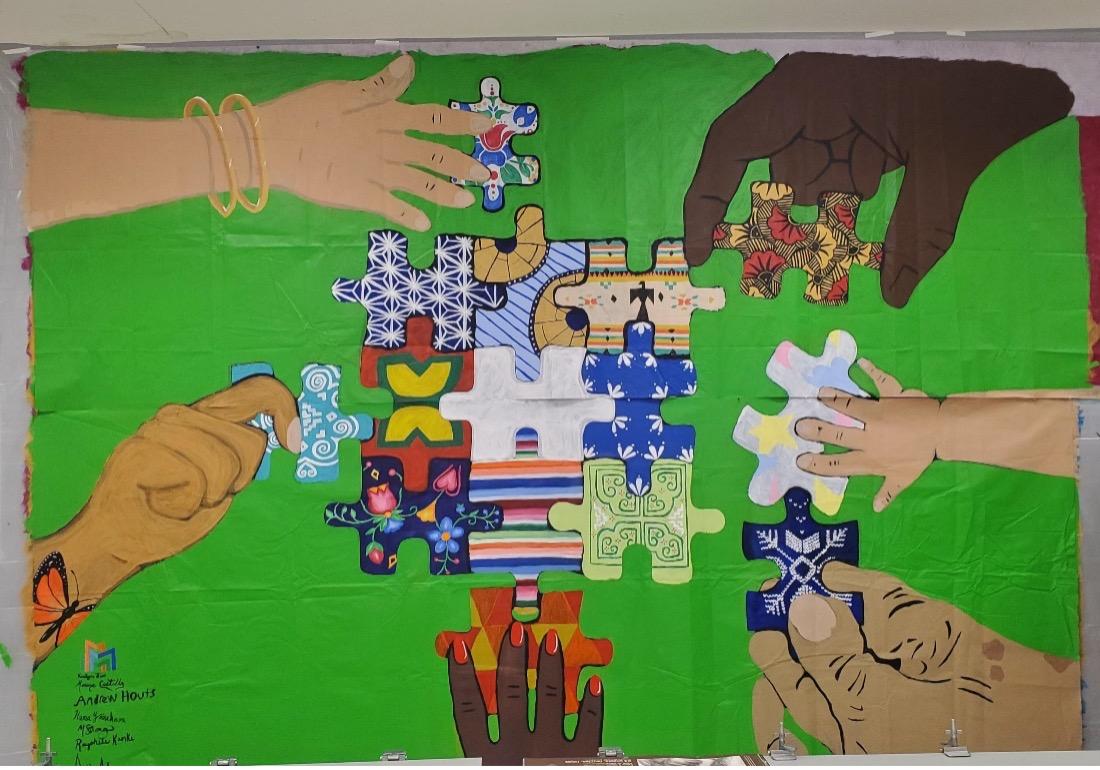
By Student Writer Padra Lor
What best describes your community in the form of art? Is it a sculpture you can find in the park, or perhaps music that involves late night karaoke at your local pub? What colors or symbols do you think of when you think about your community and the people who live in it? For students in the Metro State course ARTS 301: Art as Activism taught by community faculty member Melodee Strong, their vision entails a mural where different puzzle pieces representing the diverse cultures found in Saint Paul come together as one, showing that the whole cannot be made of a singular piece, absent the area’s diversity. It’s a vibrant visual that aims to remind the community that we are all in this together.
In the fall of 2022, the mural community project came to fruition when artist, illustrator, and teacher Melodee Strong received a grant from the Institute for Community Engagement and Scholarship to integrate a community-engaged project into her course, Art as Activism. Although Strong recently began teaching at Metro in the Spring of 2022, she has taught for more than 20 years at a variety of different institutions, teaching middle-schoolers to university students. Strong is accustomed to getting her students talking about activism and advocacy, and what projects they can pursue that use art to talk about a variety of subjects. Art as Activism, however, was her first experience designing a whole course around advocacy. The goal: to promote healing in the community through art and to give her students the real-world experience of working directly with a client—in this case, the youth-serving organization Cookie Cart, with whom they partnered to create the mural.
When asking Rayshele Kamke, a student in the course, if she was nervous about talking to community members, she tells me that she was extremely excited to be working on this project. Both Strong and Kamke wished they could have connected even more with community members than their schedules allowed. The first lesson they learned is that being open and adaptable to change is critical to constructive working relationships in community. In the end, both Strong and Kamke are very happy with the outcome of their work.
Students in the course initially worked in groups of two to create mural designs and would then collaborate as a whole class to merge ideas together to create even better designs. Cookie Cart ultimately decided the design that would be the best fit for the community. Kamke tells me that it was not only exciting and fun to be a part of this project, but she also learned a lot about herself as an individual and being an artist, including various mural techniques and even new painting methods by observing her peers. Most importantly, throughout this project, she also understood better how art brings people together.
Ninety percent of the students in the class identified as Black, Indigenous, or People of Color. Painting side-by-side and conversing with one another had a profound impact. As Kamke put it, “Art allowed us to talk about our cultures in a positive way and how it can come together and be part of one piece of art ... There’s a connection there, even without words, just understanding each other; it's very healing [because] it breaks down barriers and you get to connect on a level with people that maybe you hadn't had an opportunity [to do] before ...” That is always needed when it comes to being human.
Strong says she sees first-hand how art can bring people together and transform them. She tells me that “Whether that’s creatively or if it's with our feelings or emotions, we need a release and art is a beautiful way of doing that. I mean, the smiles that people put on their faces; that’s healing.” The impact is especially great in a collective art piece like the mural. “Every time you feel like you're contributing to something, it doesn’t have to be a formal thing, that’s what healing is. It makes you feel like you have a purpose and that you're a part of something bigger than yourself.”
Although the project changed course considerably over the eight weeks, Strong is pleased with the process and the result. She hopes that community members, too, will look at the mural and understand, especially at times when people may feel estranged from each other, that we are all one people.
Healing can take many different shapes and forms. For Strong and her students, making public art together proved to be a powerful medium of expression—a lasting one to promote a greater sense of well-being and togetherness in the very diverse spaces of the East Side.
